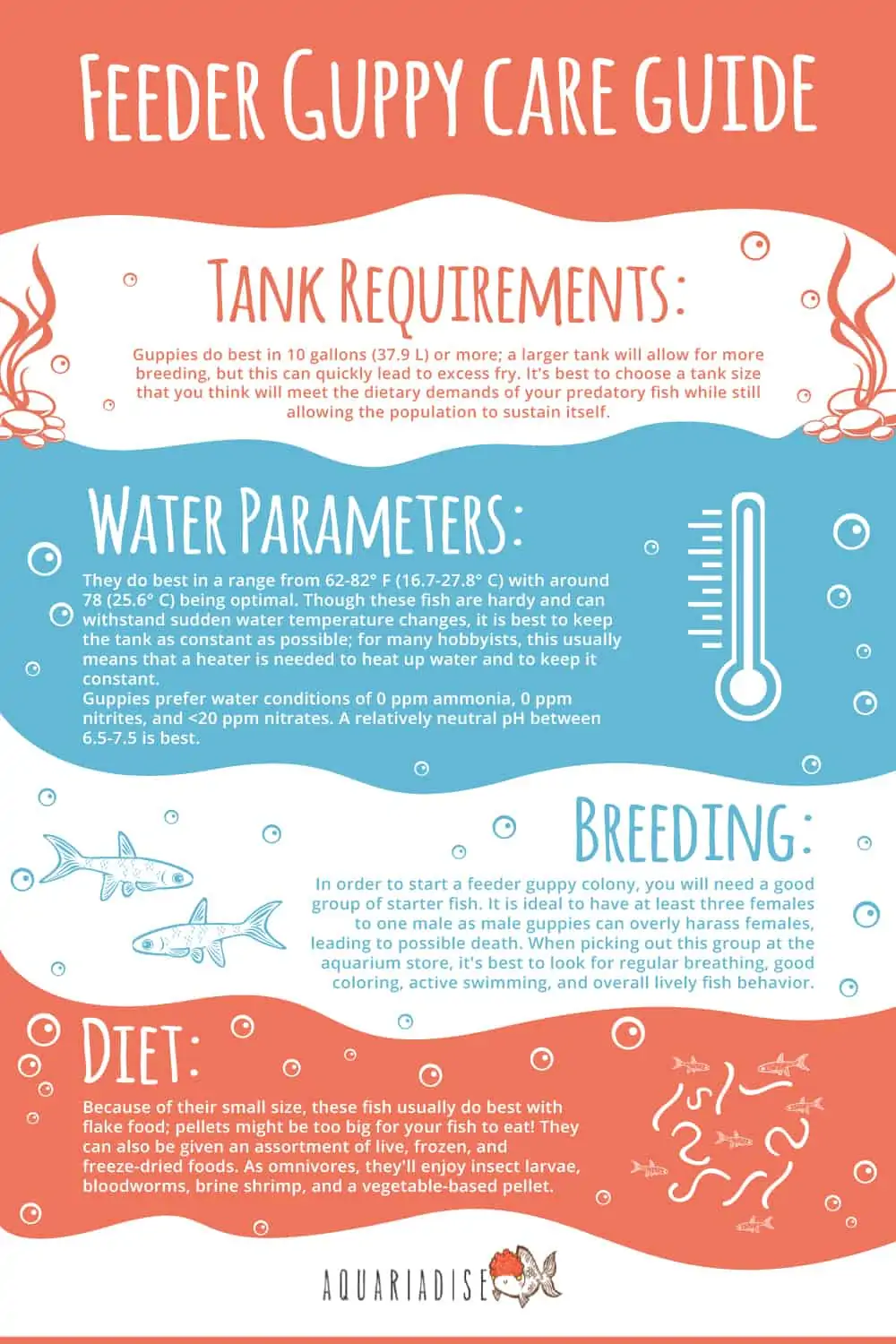If you have a predatory fish, you might have been recommended to feed live fish in order to stimulate natural hunting instincts and to give a varied diet. The problem is that many feeder fish carry diseases that can be passed to your fish and/or introduced to the rest of the livestock. Even more so, it can become expensive over time, and going to the store can become a chore.
Luckily, feeder guppies are particularly easy to breed and will offer your fish the excitement and nutrition that it needs. There isn’t too much involved with setting up the perfect breeding tank for guppies, but it’s best to set up the aquarium right the first time so you don’t have to make adjustments later on!

What are feeder guppies?
Guppies are scientifically known as Poecilia reticulata, but may also go by millionfish or rainbowfish. There are many different breeds of guppies, including the popular fancy guppies that come in all different colors.
Feeder guppies are usually much less colorful and come in shades of browns and greys. These fish come from South America and the Southern Caribbean where they thrive in most environmental conditions and ecosystems (including brackish water), especially those with dense vegetation and a healthy coating of algae and plant matter. They reach a maximum length of 2.5 inches (6.4 cm) with males growing slightly smaller than females but being much more colorful in comparison.
Should you feed your fish feeder guppies?
Feeder guppies are a favorite to breed for live food because of their high adaptability to changing water conditions and quick reproduction rate. However, does that mean that you should feed your fish feeder guppies?
Most larger species of freshwater fish will gladly eat adult feeder guppies, like oscars and other cichlids. Almost all omnivorous freshwater community fish will also enjoy guppy fry from time to time. However, some hobbyists have found that their fish can become pickier over time if fed too much live food, and might even start to refuse flakes and pellets.
The bigger concern with using live foods, however, is the risk of disease and parasites. Feeder fish and invertebrates are not cared for the same way other freshwater and saltwater fish are at the pet store–which is still usually the bare minimum. This means that there are usually tons of sick and dead fish intermixed with relatively healthy ones. Sadly, those healthy ones usually don’t make it past the first few days or weeks either because of poor water conditions, stress, disease, and general poor care.
What this means is that you could pick out healthy-looking fish from those feeder fish tanks, and still end up introducing sick fish into your aquarium and/or opening a bag full of dead fish once you get home from the pet store.
However, once in a while, you will get a relatively healthy pair of fish that can then be used to start a population where you can regulate the overall health and quality of fish.
How long do feeder guppies live?
Believe it or not, feeder guppies can actually live between 2-5 years given the right care. Their lifespan is dramatically shortened to just a few days or weeks due to poor water conditions and overall poor care.
Breeding feeder guppies
Many fish breeders selectively breed guppies for their bright colors and flowing fins. Luckily, breeding feeders isn’t nearly as involved as that.
In order to start a feeder guppy colony, you will need a good group of starter fish. It is ideal to have at least three females to one male as male guppies can overly harass females, leading to possible death. When picking out this group at the aquarium store, it’s best to look for regular breathing, good coloring, active swimming, and overall lively fish behavior.
It is very possible that there are other sick or dead fish in the same aquarium, but it is nearly impossible to find a healthy batch and this is often as good as it will get. It can also be difficult to treat these fish for disease and parasites as they seem to die before there is any hope. It might take a few trips to the aquarium store and buying in bulk in order to get a few that survive and become viable for breeding.
If serious about starting a quality population, then it is recommended to look for reputable feeder guppy breeders.
Can feeder guppies breed with fancy guppies?
Because feeder guppies and fancy guppies are the same genera, they can breed without any repercussions. However, there doesn’t seem to be a huge benefit for doing this as the offspring will usually be slightly more colorful wild type colorations and nothing overly desirable; some expert breeders may be able to manipulate these traits into uncommon variations.
It is important to note that while inbreeding is usually frowned upon in general, guppy breeders have found little to no ill-effects from accidental–or even intentional–inbreeding practices. Inbreeding is very common among experienced fish breeders as a technique to produce steady expressions of traits; however, inbreeding is never recommended unless carefully watched with results being recorded. If you notice that your fish are starting to mutate in shape, color, or behavior, it may be a sign that you have gone too far with that line.
Otherwise, it can be extremely difficult, if not impossible, to keep track of free-range guppy pairings in the aquarium. The only way to be certain that your guppies aren’t inbreeding is by keeping males and females in their own tanks and only putting them together for momentary breeding.
Feeder guppy care and tank setup
When setting up a feeder guppy tank, you should plan it as though it’s any other freshwater display aquarium. You want to yield the most from your fish, which will only happen if you give the conditions necessary for them to thrive.
Guppies do best in 10 gallons (37.9 L) or more; a larger tank will allow for more breeding, but this can quickly lead to excess fry. It’s best to choose a tank size that you think will meet the dietary demands of your predatory fish while still allowing the population to sustain itself. In general, we recommend between 20-40 gallons (75.7-151.4 L) to allow for breeding and for growing out the fry.
The aquarium may have sand or gravel substrate; as top and middle water column swimmers, these fish don’t necessarily need a substrate, which can make cleaning the tank easier. These fish appreciate lots of live plants for fry to hide in and grow. These plants do not need a high-tech setup and fluorescent lighting is usually enough. Some recommended low-light species of plants are Amazon sword (Echinodorus grisebachii), Java moss (Taxiphyllum barbieri), hornwort (Ceratophyllum demersum), and Amazon frogbit (Limnobium laevigatum).
A filter is necessary for keeping guppies. However, regular hang on the back filters will usually have the power to suck up fry and even smaller adults. It’s recommended to install a pre-filter sponge on the intake of the filter or use a sponge filter altogether.
Do feeder guppies need a heater?
Yes, guppies need a heater. Sadly, guppies are often seen as a beginner fish that is disposable. Because of this, they aren’t always kept in the best tank setups or water conditions.
Guppies are tropical fish and need to be kept in warmer water temperatures. They do best in a range from 62-82° F (16.7-27.8° C) with around 78 (25.6° C) being optimal. Though these fish are hardy and can withstand sudden water temperature changes, it is best to keep the tank as constant as possible; for many hobbyists, this usually means that a heater is needed to heat up water and to keep it constant.
Water parameters
Otherwise, guppies prefer water conditions of 0 ppm ammonia, 0 ppm nitrites, and <20 ppm nitrates. A relatively neutral pH between 6.5-7.5 is best.
Feeding feeder guppies
Besides just keeping your fish healthy, you will need to consider their diet; if you think of your systems as a food chain, anything that your guppies eat will also be absorbed by your larger fish. This gives you total control over what you feed your predatory fish from the start.
In order to plump up your guppies, you will want to feed high-quality food regularly; guppies will eat until they physically can’t anymore, which can actually lead to some serious health problems. It’s best to feed your fish once or twice a day, though some hobbyists even choose to limit it to once every two days.
Because of their small size, these fish usually do best with flake food; pellets might be too big for your fish to eat! They can also be given an assortment of live, frozen, and freeze-dried foods. As omnivores, they’ll enjoy insect larvae, bloodworms, brine shrimp, and a vegetable-based pellet.
Remember that whatever you choose to feed your feeder guppies will reflect on the fish that they are being fed to!
Conclusion
Feeder guppies are bred for quantity over quality; this often leads to sick guppy fish that can affect your entire tank. The best way to have a reliable source of live food is by cultivating a colony of guppies on your own.
These fish do best in planted aquariums where the fry have lots of vegetation to hide and grow. They need a filter, heater, high-quality diet, and a steady range of water parameters to produce the best quality food for your larger fish.
If you have any questions about feeder fish, other breeds of guppies, or have had experience providing a live diet for one of your larger fish, don’t hesitate to leave a comment below!



Can fake plants be used instead of live ones?
Yes! Just make sure that they don’t have sharp edges.
So can fancy guppies be bred as feeder options?
Using to feed Axolotl
Yes! They can.